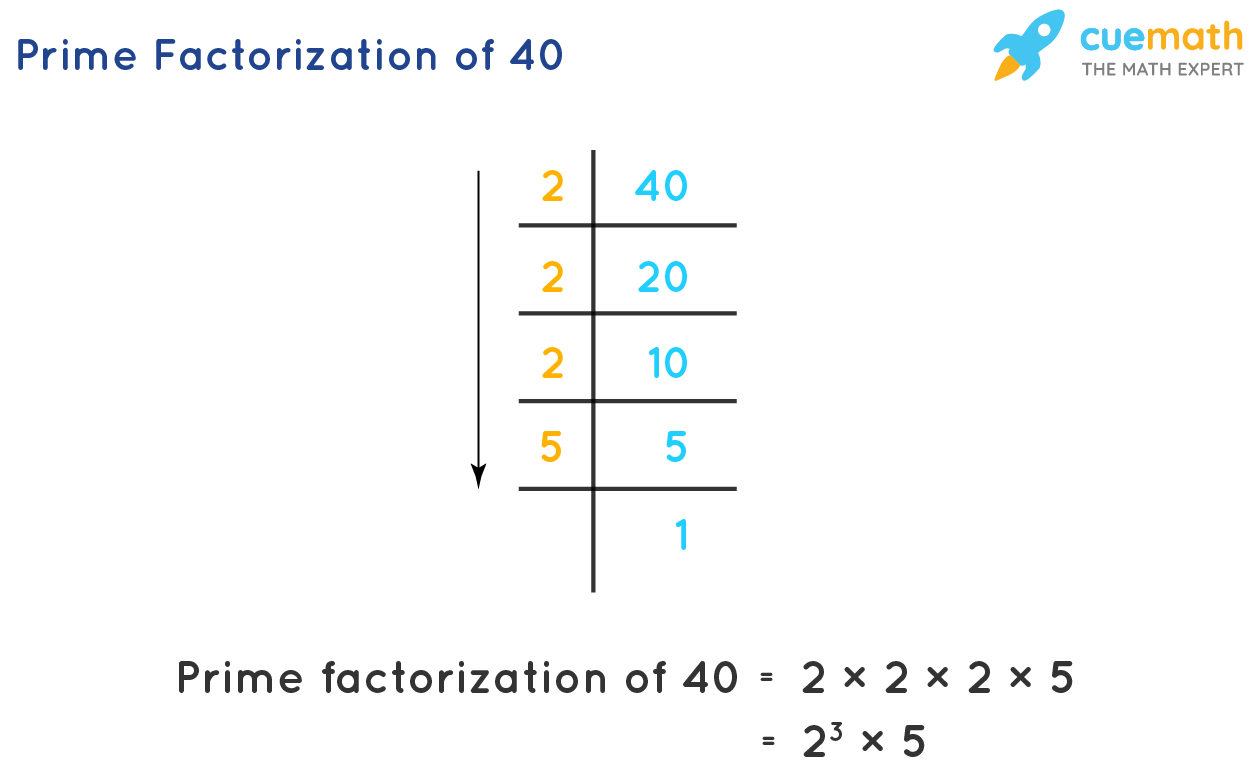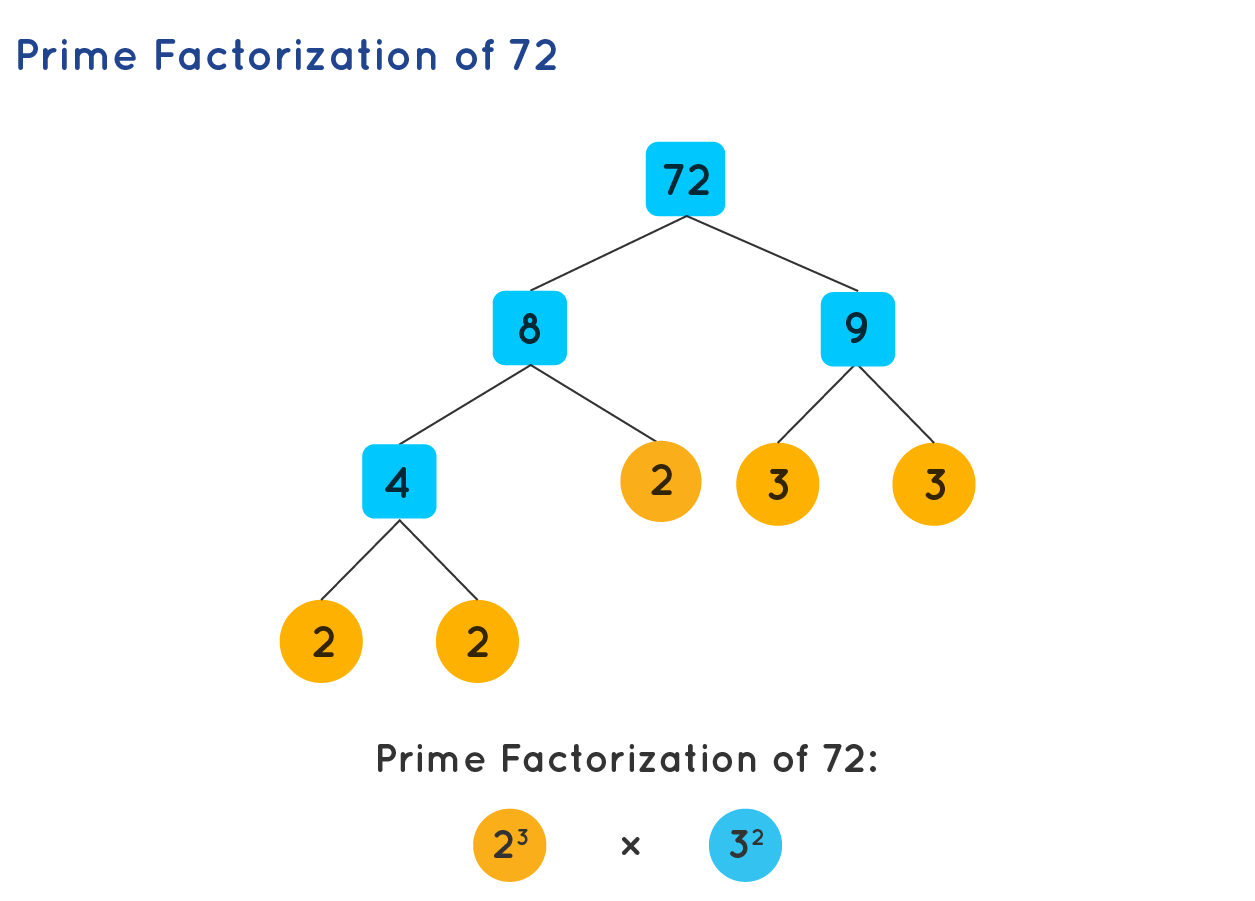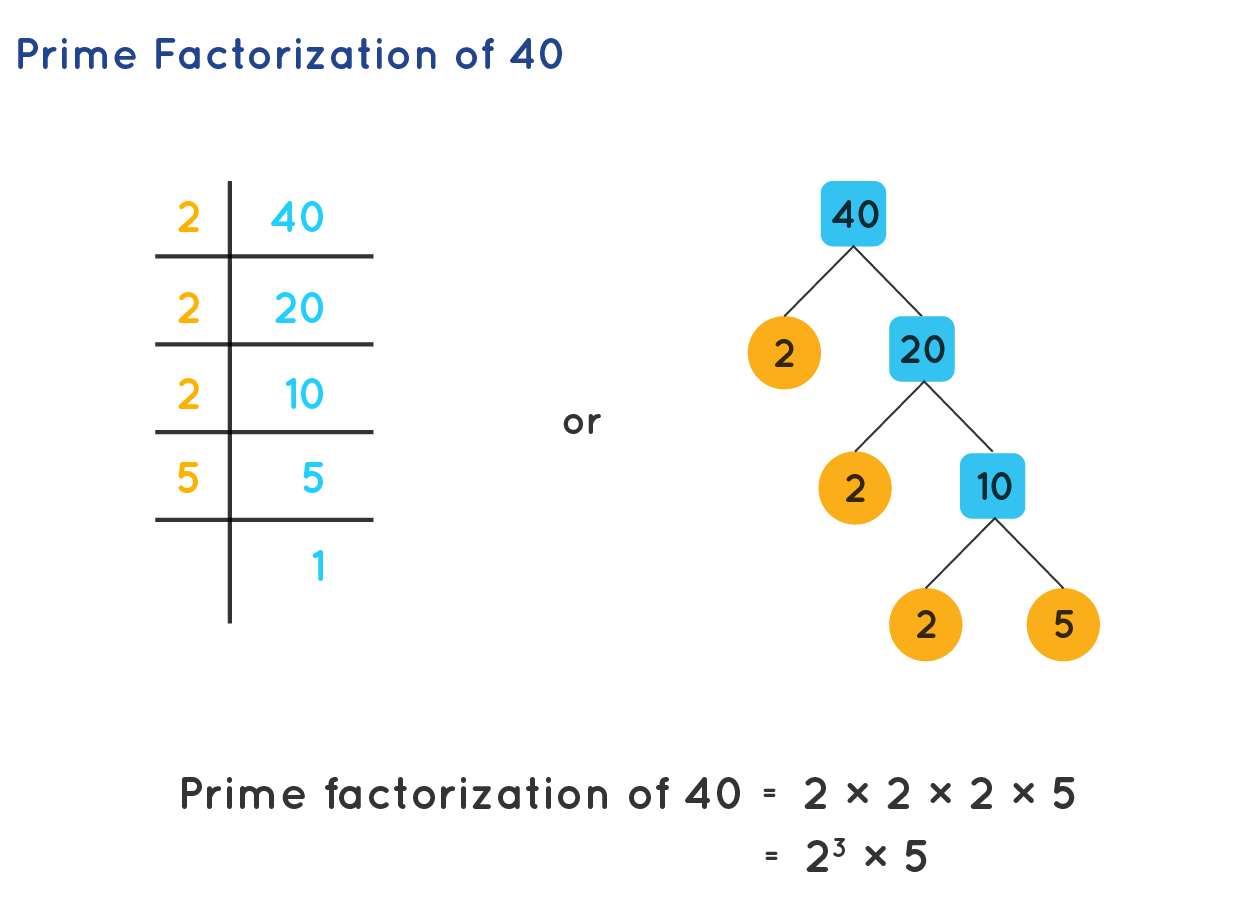Prime Factorization
Prime factorization is a way of expressing a number as a product of its prime factors. A prime number is a number that has exactly two factors, 1 and the number itself. For example, if we take the number 30. We know that 30 = 5 × 6, but 6 is not a prime number. The number 6 can further be factorized as 2 × 3, where 2 and 3 are prime numbers. Therefore, the prime factorization of 30 = 2 × 3 × 5, where all the factors are prime numbers.
Let us learn more about prime factorization with various mathematical problems followed by solved examples and practice questions.
| 1. | What is Prime Factorization? |
| 2. | Prime Factorization of a Number |
| 3. | What are Prime Factors? |
| 4. | Methods of Prime Factorization |
| 5. | FAQs on Prime Factorization |
What is Prime Factorization?
Prime factorization is the process of writing a number as the product of prime numbers. Prime numbers are the numbers that have only two factors, 1 and the number itself. For example, 2, 3, 5, 7, 11, 13, 17, 19, and so on are prime numbers. Prime factorization of any number means to represent that number as a product of prime numbers. For example, the prime factorization of 40 can be done in the following way:

Prime Factorization Meaning
The method of breaking down a number into its prime numbers that help in forming the number when multiplied is called prime factorization. In other words, when prime numbers are multiplied to obtain the original number, it is defined as the prime factorization of the number.
Prime Factorization of a Number
Let us see the prime factorization chart of a few numbers in the table given below:
| Numbers | Prime Factorization |
|---|---|
| 36 | 22 × 32 |
| 24 | 23 × 3 |
| 60 | 22 × 3 × 5 |
| 18 | 2 × 32 |
| 72 | 23 × 32 |
| 45 | 32 × 5 |
| 40 | 23 × 5 |
| 50 | 2 × 52 |
| 48 | 24 × 3 |
| 30 | 2 × 3 × 5 |
| 42 | 2 × 3 × 7 |
What are Prime Factors?
The prime factors of a number are the 'prime numbers' that are multiplied to get the original number. For example, 2 and 5 are the prime factors of 20, i.e., 2 × 2 × 5 = 20. We know that the factors of a number are the numbers that are multiplied to get the original number. For example, 4 and 5 are the factors of 20, i.e., 4 × 5 = 20. Therefore, it should be noted that all the factors of a number may not necessarily be prime factors.
Prime factorization is similar to factoring a number but it considers only prime numbers (2, 3, 5, 7, 11, 13, 17, 19, and so on) as its factors. Therefore, it can be said that factors that divide the original number completely and cannot be split into more factors are known as the prime factors of the given number.
Methods of Prime Factorization
There are various methods for the prime factorization of a number. The most common methods that are used for prime factorization are given below:
- Prime factorization by factor tree method
- Prime factorization by division method
Prime Factorization by Factor Tree Method
In the factor tree method, the factors of a number are found and then those numbers are further factorized until we reach the prime numbers. Let us understand the prime factorization of a number using the factor tree method with the help of the following example.
Example: Do the prime factorization of 850 using the factor tree.
Solution: Let us get the prime factors of 850 using the factor tree given below.
- Step 1: Place the number, 850, on top of the factor tree.
- Step 2: Then, write down the corresponding pair of factors as the branches of the tree. Here, they are 25 and 34.
- Step 3: Factorize the composite factors that are found in step 2, and write down the pair of factors as the next branches of the tree. Here, 25 can be further factorized into 5 × 5, and 34 can be factorized into 17 × 2
- Step 4: Repeat step 3, until we get the prime factors of all the composite factors. So, we get the prime factors of 850 = 2 × 52 × 17

Prime Factorization by Division Method
The division method can also be used to find the prime factors of a large number by dividing the number by prime numbers. Let us learn how to find the prime factors of a number by the division method using the following example.
Example: Do the prime factorization of 60 with the division method.
- Step 1: Divide the number by the smallest prime number such that the smallest prime number should divide the number completely. Here we divide 60 by 2 to get 30.
- Step 2: Again, divide the quotient of step 1 by the smallest prime number. So, 30 is again divided by 2 and we get 15.
- Step 3: Repeat step 2, until the quotient becomes 1. Now, 15 is not divisible by 2, so we take the next prime number which is 3. And 15 ÷ 3 = 5. Then we divide 5 ÷ 5 = 1. Since we get 1 as the quotient, we stop here.
- Step 4: Finally, multiply all the prime factors that are the divisors. Prime factorization of 60 = 2 × 2 × 3 × 5

Therefore, the prime factors of 60 are 2, 3, and 5.
Applications of Prime Factorization
Prime factorization is used extensively in the real world. The two most important applications of prime factorization are given below.
- Cryptography and Prime Factorization
- HCF and LCM Using Prime Factorization
Cryptography and Prime Factorization
Cryptography is a method of protecting information using codes. Prime factorization plays an important role for the coders who create a unique code using numbers which is not too heavy for computers to store or process quickly.
HCF and LCM Using Prime Factorization
To find the Highest Common Factor (HCF) and the Least Common Multiple (LCM) of two numbers, we use the prime factorization method. For this, we first do the prime factorization of both the numbers. The following points related to HCF and LCM need to be kept in mind:
- HCF is the product of the common prime factors with the smallest powers.
- LCM is the product of the common prime factors with the highest powers
Example: What is the HCF and LCM of 850 and 680?
Solution: We will first do the prime factorization of both the numbers.
- The prime factorization of 850 is: 850 = 21 × 52 × 171
- The prime factorization of 680 is: 680 = 23 × 51 × 171
- Observing this, we can see that the common prime factors of 850 and 680 with the smallest powers are 21, 51 and 171, and the common prime factors with the highest powers are 23, 52, 171
- HCF is the product of the common prime factors with the smallest powers. Hence, HCF of (850, 680) = 21 × 51 × 171 = 170
- LCM is the product of the common prime factors with the highest powers. Hence, LCM of (850, 680) = 23 × 52 × 171 = 3400
- Thus, HCF of (850, 680) = 170, LCM of (850, 680) = 3400
☛ Related Articles
- Prime Factorization of 60
- Prime Factorization of 36
- Prime Factorization of 30
- Prime Factorization of 64
- Prime Factorization of 45
- Prime Factorization of 50
- Prime Factorization of 48
- Prime Factorization of 40
- Prime Factorization of 8
- Prime Factorization of 24
- Prime Factorization of 12
- Prime Factorization of 72
- Prime Factorization of 18
- Prime Factorization of 42
Prime Factorization Examples
-
Example 1: Express 1080 as the product of prime factors.
Solution:
We will do the prime factorization of 1080 as follows:

Thus, 1080 = 23 × 33 × 5
Therefore, the prime factorization of 1080 is 23 × 33 × 5
-
Example 2: Find the lowest common multiple of 48 and 72 using prime factorization.
Solution:
We will do the prime factorization of 48 and 72 as shown below:

The prime factorization of 72 is shown below:

So, the prime factors of 48 = 24 × 31
the prime factors of 72 = 23 × 32
Observing this we can see that the common prime factors of 48 and 72 with the greatest powers are 24, 32
The LCM of any 2 numbers is the product of the common prime factors with the greatest powers. Hence, LCM (48, 72) = 24 × 32 = 144
Therefore, LCM (48, 72) = 24 × 32 = 144
-
Example 3: Show the prime factorization of 40 using the division method and the factor tree method.
Solution:
Let us use the division method and the factor tree method to prove that the prime factorization of 40 will always remain the same.

Therefore, this shows that by any method of factorization, the prime factorization remains the same. The prime factorization for a number is unique.

FAQs on Prime Factorization
What is Prime Factorization in Math?
Prime factorization of any number means to represent that number as a product of prime numbers. A prime number is a number that has exactly two factors, 1 and the number itself. For example, the prime factorization of 18 = 2 × 3 × 3. Here 2 and 3 are the prime factors of 18.
How to do Prime Factorization?
Prime factorization of any number can be done by using two methods:
- Division method - In this method, the given number is divided by the smallest prime number which divides it completely. After this, the quotient is again divided by the smallest prime number. This step is repeated until the quotient becomes 1. Then, all the prime factors that are divisors are multiplied.
- Factor tree method - In this method, the given number is placed on top of the factor tree. Then, the corresponding pairs of factors are written as the branches of the tree. After this step, the composite factors are again factorized and written down as the next branches. This procedure is repeated until we get the prime factors of all the composite factors. A detailed explanation of both these methods, with examples, is given above on this page.
What are Prime Factors of a Number?
The prime factors of a number are the 'prime numbers' that are multiplied to get the original number. For example, 2 and 3 are the prime factors of 12, i.e., 2 × 2 × 3 = 12. It can also be said that factors that divide the original number completely and cannot be split further into more factors are known as the prime factors of the given number. It should be noted that 4 and 6 are also factors of 12 but they are not prime numbers, therefore, we do not write them as prime factors of 12.
What is the Prime Factorization of 72, 36, and 45?
Prime factorization is the way of writing a number as the multiple of their prime factors. The first few prime numbers are 2, 3, 5, 7, 11, 13, 17, 19, and so on. The prime factorization of 72, 36, and 45 are shown below.
- Prime factorization of 72 = 23 × 32
- Prime factorization of 36 = 22 × 32
- Prime factorization of 45 = 32 × 5
How to Find LCM using Prime Factorization?
The abbreviation LCM stands for 'Least Common Multiple'. The Least Common Multiple (LCM) of a number is the smallest number that is the product of two or more numbers. The LCM of two numbers can be calculated by first finding out the prime factors of the numbers. The LCM is the product of the common prime factors with the greatest powers. For example, let us find the LCM of 12 and 18. The prime factorization of 12 = 22 × 31, and the prime factorization of 18 = 21 × 32. Among the common prime factors, the product of the factors with the highest powers is 22 × 32 = 36.
How to Find HCF using Prime Factorization?
The abbreviation HCF stands for 'Highest Common Factor'. The Highest Common Factor (HCF) of two numbers is the highest possible number which divides both the numbers completely. The HCF of two numbers can be found out by first finding out the prime factors of the numbers. The HCF is the product of the common prime factors with the smallest powers. For example, let us find the HCF of 12 and 18. The prime factorization of 12 = 22 × 31, and the prime factorization of 18 = 21 × 32. Among the common prime factors, the product of the factors with the smallest powers is 21 × 31 = 6.
Why is Prime Factorization Important?
Prime factorization is used to find the HCF and LCM of numbers. It is widely used in cryptography which is the method of protecting information using codes. Prime numbers are used to form or decode those codes.
What is the Prime Factorization of 24?
The number 24 can be written as 4 × 6. Now the composite numbers 4 and 6 can be further factorized as 4 = 2 × 2 and 6 = 2 × 3. Therefore, the prime factorization of 24 is 24 = 2 × 2 × 2 × 3 = 23 × 3
How is Prime Factorization used in the Real World?
Prime factorization is used extensively in the real world. For example, if we need to divide anything into equal parts, or we need to exchange money, or calculate the time while travelling, we use prime factorization. One common example is, if we have 21 candies and we need to divide it among 3 kids, we know the factors of 21 as, 21 = 3 × 7. This means we can distribute 7 candies to each kid.
When to use Prime Factorization?
Prime factorization is one of the methods used to find the Greatest Common Factor (GCF) of a given set of numbers. GCF by prime factorization is useful for larger numbers for which listing all the factors is time-consuming.
How to Find Prime Factors of a Number?
The prime factors of a number can be listed using various methods. It should be noted that prime factors are different from factors because prime factors are prime numbers that are multiplied to get the original number. One of the methods to find the prime factors of a number is the division method. Let us use this method to find the prime factors of 24.
- In this method, the given number is divided by the smallest prime number which divides it completely. So, 24 ÷ 2 = 12.
- After this, the quotient is again divided by the smallest prime number. So 12 ÷ 2 = 6.
- This step is repeated until the quotient becomes 1. This means 6 ÷ 2 = 3. Now 3 cannot be further divided or factorized because it is a prime number.
- Then, all the prime factors that are divisors are multiplied and listed.
- So we get 24 = 2 × 2 × 2 × 3 and we know that the prime factors of 24 are 2 and 3 and the prime factorization of 24 = 23 × 3
What is the Definition of Prime Factorization?
Prime factorization is defined as the way of expressing a number as a product of its prime factors. We know that a prime number is a number that has exactly two factors, 1 and the number itself. For example, if we take the number 20. We know that 20 = 5 × 4, but 4 is not a prime number. The number 4 can further be factorized as 2 × 2, where 2 is a prime number. Therefore, the prime factorization of 20 = 2 × 2 × 5, where all the factors are prime numbers.
visual curriculum